45
Special Issue
JOURNAL OF SCIENCE AND TECHNOLOGY DONG NAI TECHNOLOGY UNIVERSITY
COMPARATIVE ANALYSIS OF BLOCKCHAIN-BASED VOTING SYSTEMS USING MACHINE LEARNING TECHNIQUES
Nguyen Tai Tiep*
Dong Nai Technology University *Corresponding author: Nguyen Tai Tiep, nguyentaitiep@dntu.edu.vn
GENERAL INFORMATION
Received date: 20/03/2024
Revised date: 13/05/2024
these
reliability of
systems vary
Accepted date: 11/07/2024
KEYWORD
Blockchain;
Cryptocurrency; Decentralization;
insights
into
Distributed Ledger Technology;
Smart Contracts.
ABSTRACT Integrating Blockchain technology into electronic voting systems promises to enhance security, transparency, and efficiency in electoral processes. However, the performance significantly, and necessitating a comprehensive evaluation. This research conducts a comparative analysis of various Blockchain-based voting systems using machine learning techniques to assess their performance, security, and user-friendliness. Findings reveal significant variations in system efficiency, scalability, and robustness, with distinct correlations between Blockchain architecture and overall system performance. The study provides empirical the capabilities and limitations of current Blockchain-based voting systems, emphasizing the critical role of machine learning in enhancing system analysis. Results offer valuable guidance for developing more secure, scalable, and user-friendly voting systems, paving the way for their broader adoption in democratic processes.
1. INTRODUCTION
democracy (Ashfaq et al., 2022; Pandey & Rarhi, 2023).
technology
immutability –
inherent
In an age defined by rapid technological advancement and digital transformation, the integration of blockchain into various sectors has emerged as a paradigm- shifting phenomenon. Among the myriad applications of blockchain, electronic voting systems have captured considerable attention due to their potential to address longstanding challenges traditional voting in mechanisms. Issues such as electoral fraud, tampering, and lack of transparency have plagued electoral processes around the world, of very undermining foundations the
Blockchain-based voting systems (BBVS) offer a compelling solution to these challenges by leveraging the core attributes of blockchain technology – decentralization, transparency, and to create a secure, verifiable, and efficient platform for casting and tallying votes (Jafar et al., 2021, 2022). By decentralizing the process of vote recording and verification, BBVS aim to eliminate single points of failure and reduce the risk of tampering or manipulation, thereby enhancing the integrity and trustworthiness of electoral outcomes (Alvi et al., 2020, 2022).
JOURNAL OF SCIENCE AND TECHNOLOGY DONG NAI TECHNOLOGY UNIVERSITY
46
Special Issue
how demonstrating
increasing voter
advanced cryptographic techniques and smart contracts, these technologies can be integrated to create robust and tamper-proof voting systems. This study underscores the importance of incorporating advanced security measures to protect against evolving threats. explore
The potential benefits of BBVS are manifold. Beyond mitigating the risk of electoral fraud, blockchain technology holds the promise of turnout, streamlining the voting process, and facilitating remote and secure participation in electoral events. Countries like Estonia have already the possibilities of begun to blockchain-based systems, with voting initiatives such as Estonia's e-Residency program showcasing the feasibility and efficacy of this innovative approach on a national scale (Tanwar et al., 2020).
systems Moreover, Pandey & Rarhi (2023) explored learning and the application of machine blockchain in developing a right-to-recall voting system. Their research illustrated the potential of machine learning algorithms to predict voter behavior and detect anomalies, thereby enhancing the overall security and reliability of BBVS. This study highlights the synergy between blockchain and machine learning in creating adaptive and resilient voting systems.
scalability, privacy, the
However, despite the promise of BBVS, their widespread adoption and effective implementation present formidable challenges. The performance, security, and usability of blockchain-based vary voting significantly depending on factors such as system architecture, consensus mechanisms, and user interfaces. Moreover, concerns persist and regarding accessibility of BBVS, underscoring the need for comprehensive evaluation and optimization (Alam et al., 2018). performance metrics,
investigation and
Our study endeavors to conduct a rigorous comparative analysis of BBVS using advanced machine learning techniques. By harnessing the analytical power of machine learning, we aim to delve into the intricacies of different blockchain-based voting systems, examining security their vulnerabilities, and user experiences. Through empirical data-driven analysis, our study seeks to provide valuable insights into the strengths, weaknesses, and underlying dynamics of existing BBVS.
of research aims blockchain-based to security. Their
implementing BBVS in Recent research has delved deeply into these aspects, exploring innovative solutions and identifying critical challenges. Jafar et al. (2022) conducted a systematic literature review and meta-analysis on scalable blockchain- based electronic voting systems, emphasizing the need for scalable and efficient solutions capable of handling large voter bases without compromising findings the complexities of achieving highlight scalability in BBVS while maintaining the decentralized nature of blockchain.
utilizing research Another significant study by Fezzazi et al. (2021) proposed an intelligent and secure blockchain voting framework technology. Their focused on enhancing the security of BBVS through By shedding light on the capabilities and voting limitations systems, our inform stakeholders, policymakers, and technologists about the potential and challenges associated with real-world electoral contexts. Furthermore, by leveraging machine learning as a tool for analysis, we aspire to contribute to the ongoing dialogue surrounding digital democracy, electoral integrity, and the future of participatory governance in the digital age.
47
Special Issue
JOURNAL OF SCIENCE AND TECHNOLOGY DONG NAI TECHNOLOGY UNIVERSITY
2. Literature Review
networks can experience significant slowdowns when handling large volumes of transactions, which is a critical factor during elections with high voter turnout. Research by Liu et al. (2020) explored the scalability issues in blockchain networks and proposed various optimization techniques, but these solutions often involve trade-offs between speed and security. Security vulnerabilities, such as the risk of a 51% attack where a single entity gains majority control of the network, have also been highlighted as critical risks that need continuous monitoring and mitigation. These challenges underscore the need for a balanced approach in designing BBVS that can scale effectively while maintaining robust security protocols.
learning Machine
Evolution of voting systems: The evolution of voting systems has been marked by significant shifts from traditional paper-based methods to electronic and now blockchain- based solutions. Initially, paper ballots were the standard, offering simplicity but also being prone to issues such as ballot stuffing and miscounting. With the advent of electronic voting, the focus shifted towards improving the efficiency and speed of vote tallying. However, introduced new electronic voting systems challenges, particularly in terms of security, transparency, and voter trust. The move towards blockchain-based voting systems (BBVS) is seen as a natural progression, leveraging the decentralized and immutable nature of blockchain technology to address these persistent issues.
in Blockchain
like
security, transparency,
in voting systems: Machine learning has emerged as a powerful tool in enhancing the efficiency and reliability of voting systems, particularly in tasks such as fraud detection, voter behavior analysis, and that of system optimization. Studies Estevez et al. (2018) have shown how machine learning algorithms can identify patterns and anomalies in voting data that might indicate fraudulent activities. Additionally, machine learning can be used to predict voter turnout, optimize resource allocation, and enhance the overall user experience by personalizing interfaces based on voter preferences and behaviors. The integration of machine learning into BBVS offers new opportunities to address the complexities of modern electoral processes, though it also introduces new challenges related to data privacy and algorithmic transparency.
voting: technology Blockchain technology, with its decentralized ledger system, has been widely recognized for its potential to revolutionize voting systems by enhancing and auditability. Several studies have highlighted the core attributes of blockchain, such as immutability, which ensures that once a vote is cast, it cannot be altered, and decentralization, which reduces the risk of centralized attacks. For instance, a study by McCorry et al. (2017) demonstrated how blockchain could prevent double voting and provide a transparent audit trail. However, these studies also emphasize the complexity of implementing blockchain in a voting context, particularly in ensuring that the system remains user-friendly while upholding the principles of democratic transparency.
the in Challenges in blockchain-based voting: Despite its potential, blockchain-based voting systems face several challenges that have been extensively discussed literature. Scalability is a major concern, as blockchain Comparative studies on blockchain-based voting systems: Existing comparative studies on BBVS have typically focused on specific aspects such as security, scalability, and user experience. For instance, a comparative study by Zhao et al. (2019) evaluated several BBVS based on their transaction speeds, security protocols, and ease of use, concluding that no
JOURNAL OF SCIENCE AND TECHNOLOGY DONG NAI TECHNOLOGY UNIVERSITY
48
Special Issue
adherence
alongside rigorous
single system excels in all areas. This body of research provides valuable insights but often lacks a comprehensive analysis that integrates multiple dimensions of system performance. The current study aims to fill this gap by employing machine learning techniques to conduct a holistic comparison of BBVS, considering factors such as transaction speed, security, scalability, and user satisfaction in a unified framework.
Recent advancements: provides also but
and weaknesses in consensus mechanisms. Specific assessment criteria are defined, including network decentralization, distribution and of mining power, to cybersecurity Quantitative standards. evaluation metrics, such as the frequency of security breaches and network resilience, are implemented testing procedures such as penetration testing and smart contract auditing. This framework not only evaluates the current security status of BBVS actionable recommendations for enhancing security and resilience against evolving threats.
to ensure
analysis, ensuring the in
Recent advancements in blockchain technology, such as the development of more scalable consensus mechanisms (e.g., Proof of Stake, Delegated Proof of Stake), and the application of advanced cryptographic techniques (e.g., zero-knowledge proofs), offer promising avenues for enhancing BBVS. These technological developments, coupled with the ongoing improvements in machine learning algorithms, particularly in the areas of anomaly detection and predictive for analytics, present new opportunities optimizing BBVS. Future research is likely to focus on the integration of these advancements to create more robust, scalable, and user- friendly voting systems. Next, the selection of BBVS is carefully representation and conducted diversity across different blockchain-based voting approaches. Criteria for system selection include architecture type, extent of use, and geographical distribution. By employing a meticulous approach, BBVS from various contexts – ranging from national elections to organizational voting – are identified and included a comprehensive and representative overview of the BBVS landscape.
3. METHODOLOGY
such to
robust security evaluation insights
learning algorithms In this study, a multifaceted methodology is analyze employed comprehensively (BBVS) blockchain-based voting systems using machine techniques. The learning methodology encompasses the development of a framework, meticulous system selection criteria, rigorous data collection methods, and the application of diverse machine for analysis.
Data collection adopts a multifaceted approach to gather relevant information for as analysis. Performance metrics transaction speed, block time, and system latency are sourced from system logs and operational reports. Security incident reports are collected from official documentation and third-party audits, providing into BBVS security posture. Additionally, user feedback is solicited through surveys and to assess user-friendliness and interviews satisfaction, quantitative complementing metrics with qualitative insights.
The machine learning analysis framework employed in this study encompasses a range of techniques to comprehensively analyze BBVS. Firstly, to ensure a thorough assessment of BBVS security, we establish a comprehensive security evaluation framework. This framework addresses critical security considerations such as vulnerability to 51% attacks, node security,
49
Special Issue
JOURNAL OF SCIENCE AND TECHNOLOGY DONG NAI TECHNOLOGY UNIVERSITY
techniques, systems emphasized
the
application voting in
performance and Early investigations into blockchain-based voting the have technology's ability to create a decentralized, immutable ledger for recording votes, thereby minimizing tampering or risk of manipulation. Researchers such as Nakamoto (2008) laid the conceptual groundwork for blockchain's by introducing the Bitcoin protocol, which served as a pioneering example of a decentralized digital currency system built on blockchain principles. techniques
implementations outliers.
Data preprocessing including normalization and transformation, are applied to standardize diverse datasets. Classification methods such as decision trees and random forests are used to categorize systems based on performance and security metrics, detect anomalies, and classify voting patterns. Support Vector Machines (SVM) and neural networks are utilized to analyze complex patterns and to predict voting behaviors, contributing security evaluation. Clustering algorithms, such as K-Means, and including anomaly detection Isolation Forest and One-Class SVM, provide insights identify into user behaviors and Principal Component security Analysis (PCA) is employed to reduce data complexity identify key variables and impacting BBVS performance.
transparency unparalleled
Python's sci-kit-learn and R's caret package are utilized for implementing machine learning algorithms, aiming for a comprehensive and robust analysis of BBVS. Each method brings unique strengths to the analysis, collectively ensuring a thorough evaluation of BBVS across performance, security, and user-friendliness dimensions.
Building upon this foundational work, subsequent studies have delved into various blockchain tailored specifically for voting applications. These implementations include public, private, and consortium blockchain models, each offering distinct advantages and challenges for electoral systems. For instance, public blockchains, like Ethereum, exemplified by platforms and provide censorship resistance but may face scalability and privacy limitations. Conversely, private and consortium blockchains offer greater control and scalability but may sacrifice some degree of decentralization and transparency (Swan, 2015). 4. FINDINGS AND DISCUSSION
4.1 Related work
techniques,
in
immutability, The security and privacy implications of blockchain-based voting systems have been a focal point of research, with scholars exploring consensus cryptographic mechanisms, and threat models to safeguard the integrity of the voting process. Studies by Juels et al. (2016) have highlighted the cryptographic strengths of blockchain in ensuring vote secrecy and verifiability while also identifying potential vulnerabilities such as 51% attacks and double-spending. it an The practicality and
scalability of blockchain-based voting systems in large-scale electoral events have been subject to scrutiny. The integration of blockchain technology into electronic voting systems has garnered widespread attention in both academic and practical spheres. Initial research in this field has underscored the transformative potential of security, the enhancing blockchain transparency, and integrity of electoral processes. Blockchain's core features, including and decentralization, cryptographic security, make ideal candidate for mitigating common challenges associated with traditional electronic voting systems.
JOURNAL OF SCIENCE AND TECHNOLOGY DONG NAI TECHNOLOGY UNIVERSITY
50
Special Issue
the capacity of BBVS to handle peak voting volumes, with some systems exhibiting greater scalability than others.
Security in
Technical challenges, including transaction throughput, system latency, and network congestion, pose significant obstacles to the widespread adoption of BBVS. Innovations such as layer-two protocols and alternative consensus mechanisms have been proposed to address these challenges, albeit with varying degrees of success (Buterin, 2014).
blockchain-based
to identified evaluations vulnerabilities, particularly consensus mechanisms, underscoring the critical need for regular security updates to mitigate risks effectively. User feedback favored systems with simpler interfaces, directly impacting voter satisfaction, although accessibility varied across systems. Comparative analysis linked blockchain architecture to both performance and security outcomes, highlighting its crucial role in BBVS design.
blockchain architecture. Machine learning has emerged as a valuable tool for enhancing the security and performance of systems. voting such as anomaly detection, Techniques predictive modeling, and data analysis enable researchers identify patterns, detect fraudulent activities, and optimize system parameters. Studies by Bonneau (2015) have demonstrated the effectiveness of machine learning in detecting anomalous behaviours in blockchain networks, thereby enhancing the overall security posture of voting systems.
that employ machine
Despite extensive research on various facets of blockchain-based voting systems, there remains a need for comprehensive comparative studies learning techniques to evaluate these systems across multiple dimensions, including performance, security, and usability. This research aims to bridge this gap by conducting a systematic analysis of BBVS using advanced machine learning methodologies, thereby providing new insights into their efficacy and potential for improving democratic processed.
4.2 Results
analysis learning The machine
architecture blockchain of into insights
transaction superior
The results emphasize the importance of continuous monitoring and adaptation in BBVS deployment to ensure effectiveness and security, with a particular focus on the impact Visual of representations, including Figure 1 depicting security incidents among BBVS, highlight disparities in security vulnerabilities across systems. Figure 2 illustrates transaction speed comparisons, with Estonia's e-Residency leading in speed, while Figure 3 demonstrates scalability analysis under increasing user load, showcasing variations in performance among BBVS. The distribution of security incidents among BBVS illustrates Voatz experiencing a higher number of incidents compared to others, emphasizing the importance of robust security measures in BBVS deployment, shown in Figure 1. A comparison of transaction speeds across BBVS shows Estonia's e-Residency leading in speed, suggesting the potential impact on transaction efficiency that shown in Figure 2. As Figure 3 shown the Scalability analysis of BBVS under increasing user load highlights variations in performance among systems, with Estonia's e-Residency, Voatz, Agora, Follow My Vote, and Polys demonstrating varying of (BBVS) blockchain-based voting systems uncovered significant their performance, security, and user experience. Notably, private blockchain architectures demonstrated speeds compared to public ones, indicating a potential trade-off between efficiency and transparency. Scalability assessments revealed variations in
51
Special Issue
JOURNAL OF SCIENCE AND TECHNOLOGY DONG NAI TECHNOLOGY UNIVERSITY
and guiding their degrees of scalability to handle larger voting populations. of various BBVS optimization and future development.
higher transaction
Figure 1. Security Incidents in BBVS
superior performance,
One key finding from the analysis is the substantial performance variability among different BBVS. Systems utilizing private generally architectures blockchain demonstrated speeds compared to those built on public blockchains. This observation highlights the inherent trade- off between efficiency and transparency in BBVS design. While private blockchains may they may offer compromise certain democratic characteristics such as openness and voter trust, which are prioritized in public blockchains. Conversely, public blockchains prioritize transparency but may encounter scalability challenges and slower transaction speeds.
Figure 2. Transaction speed comparison among BBVS
to mitigate potential
Moreover, the security evaluation identified vulnerabilities in certain BBVS, particularly those with weaker consensus mechanisms. Instances of security incidents underscore the critical importance of ongoing vigilance and regular updates to security protocols to uphold the integrity and trustworthiness of BBVS. Balancing robust security measures with the necessary transparency for electoral processes is essential risks effectively.
Figure 3. Scalability analysis of BBVS under increasing load
4.3 Discussion
User feedback played a pivotal role in assessing BBVS usability, with systems featuring simpler interfaces receiving higher satisfaction ratings from users. However, disparities in accessibility across different systems highlight the need for inclusive design practices to ensure equitable access for all eligible voters, regardless of their technological proficiency or physical abilities.
Furthermore,
The analysis of blockchain-based voting systems (BBVS) using machine learning techniques has provided valuable insights into system performance, security vulnerabilities, and user satisfaction, offering a comprehensive understanding of the strengths and limitations
the comparative analysis emphasized the significant role of blockchain architecture in shaping BBVS performance and security. Public, private, and consortium
JOURNAL OF SCIENCE AND TECHNOLOGY DONG NAI TECHNOLOGY UNIVERSITY
52
Special Issue
Overall, this research contributes to the ongoing discourse on digital democracy, providing valuable insights for optimizing voting system design and deployment in the digital age.
REFERENCE
blockchain models each offer distinct advantages and challenges, necessitating careful consideration of architectural choices based on the specific requirements of each electoral blockchain context. Aligning architecture with the objectives of BBVS is crucial to ensure effective and trustworthy electoral processes.
technologists, policymakers,
(ICISET),
Alam, A., Zia Ur Rashid, S. M., Abdus Salam, Md., & Islam, A. (2018). Towards Blockchain-Based E-voting System. 2018 on International Conference Innovations in Science, Engineering and 351–354. Technology https://doi.org/10.1109/ICISET.2018.87 45613
inform to
These findings have important implications for and stakeholders involved in BBVS development research and and deployment. Ongoing innovation are essential to address challenges such as scalability, security, and user- friendliness in BBVS. Future studies may explore advanced machine learning algorithms to enhance security and performance further. Additionally, longitudinal studies tracking the long-term performance and viability of BBVS are warranted continuous improvement efforts and optimize electoral processes effectively.
5. CONCLUSION
Alvi, S. T., Uddin, M. N., & Islam, L. (2020). Digital Voting: A Blockchain-based E- Voting System using Biohash and Smart Contract. 2020 Third International Conference on Smart Systems and Inventive Technology (ICSSIT), 228– 233. https://doi.org/10.1109/ICSSIT48917.20 20.9214250
into crucial insights
assessments scalability in
significance of the
Alvi, S. T., Uddin, M. N., Islam, L., & Ahamed, S. (2022). DVTChain: A blockchain- based decentralized mechanism to ensure the security of digital voting system voting system. Journal of King Saud University - Computer and Information Sciences, 6855–6871. 34(9), https://doi.org/10.1016/j.jksuci.2022.06. 014 linked blockchain architecture security and
blockchain-based of
The analysis of blockchain-based voting systems using machine learning techniques has provided system performance, security vulnerabilities, and user satisfaction. Private blockchain architectures transaction speeds, demonstrated superior while revealed variations system capacity. Security evaluations underscored the importance of regular security updates, and user feedback emphasized simpler interfaces for voter satisfaction. Comparative analysis to performance outcomes, emphasizing its critical role in system design. These findings highlight the necessity for continuous monitoring and adaptation in the deployment voting systems, focusing on architectural impact. Ashfaq, T., Khalid, R., Yahaya, A. S., Aslam, S., Azar, A. T., Alsafari, S., & Hameed, I. A. (2022). A Machine Learning and Blockchain Based Efficient Fraud Detection Mechanism. Sensors, 22(19), 7162. https://doi.org/10.3390/s22197162
53
Special Issue
JOURNAL OF SCIENCE AND TECHNOLOGY DONG NAI TECHNOLOGY UNIVERSITY
Learning Adoption
Access, 8,
Fezzazi, A. E., Adadi, A., & Berrada, M. (2021). Towards a Blockchain based Intelligent and Secure Voting. 2021 Fifth International Conference On Intelligent Computing in Data Sciences (ICDS), 1– 8. https://doi.org/10.1109/ICDS53782.2021 .9626751 Tanwar, S., Bhatia, Q., Patel, P., Kumari, A., Singh, P. K., & Hong, W.-C. (2020). in Machine Blockchain-Based Smart Applications: The Challenges, and a Way Forward. IEEE 474–488. https://doi.org/10.1109/ACCESS.2019.2 961372
Jafar, U., Ab Aziz, M. J., Shukur, Z., & Hussain, H. A. (2022). A Systematic Literature Review and Meta-Analysis on Scalable Blockchain-Based Electronic Voting Systems. Sensors, 22(19), 7585. https://doi.org/10.3390/s22197585
Fezzazi, A. E., Adadi, A., & Berrada, M. (2021). Towards a Blockchain based Intelligent and Secure Voting. 2021 Fifth International Conference On Intelligent Computing in Data Sciences (ICDS), 1– 8. https://doi.org/10.1109/ICDS53782.2021 .9626751
Jafar, U., Aziz, M. J. A., & Shukur, Z. (2021). Blockchain for Electronic Voting System—Review and Open Research Challenges. Sensors, 21(17), 5874. https://doi.org/10.3390/s21175874
Jafar, U., Ab Aziz, M. J., Shukur, Z., & Hussain, H. A. (2022). A Systematic Literature Review and Meta-Analysis on Scalable Blockchain-Based Electronic Voting Systems. Sensors, 22(19), 7585. https://doi.org/10.3390/s22197585
for Engineering
for Engineering
Pandey, V. R., & Rarhi, K. (2023). A Brief Review on Right to Recall Voting System Based on Performance Using Machine Learning and Blockchain Technology. In P. Chatterjee, D. Pamucar, M. Yazdani, & (Eds.), Computational D. Panchal Intelligence and Management Applications (Vol. 984, pp. 345–355). Springer Nature Singapore. https://doi.org/10.1007/978-981-19- 8493-8_27
Pandey, V. R., & Rarhi, K. (2023). A Brief Review on Right to Recall Voting System Based on Performance Using Machine Learning and Blockchain Technology. In P. Chatterjee, D. Pamucar, M. Yazdani, & (Eds.), Computational D. Panchal Intelligence and Management Applications (Vol. 984, pp. 345–355). Springer Nature Singapore. https://doi.org/10.1007/978-981-19- 8493-8_27





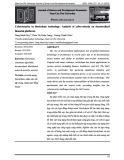
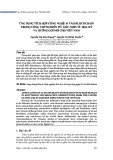

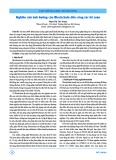
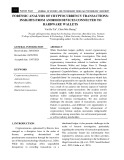
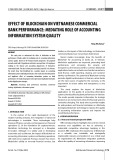








![Fintech và Ngân hàng tại Việt Nam: Hợp tác hay Cạnh tranh? [Phân tích mới nhất]](https://cdn.tailieu.vn/images/document/thumbnail/2025/20250628/nomoney1/135x160/3441751105045.jpg)






